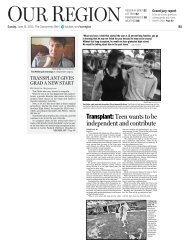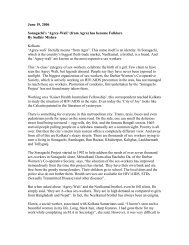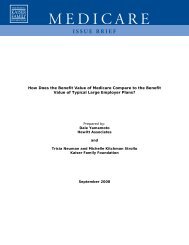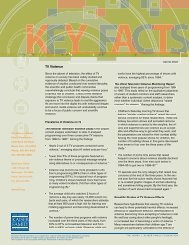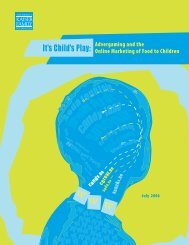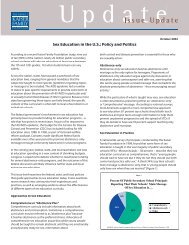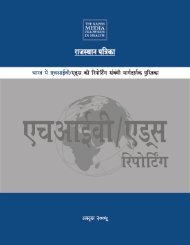HEALTH CARE COSTS: A PRimER - The Henry J. Kaiser Family ...
HEALTH CARE COSTS: A PRimER - The Henry J. Kaiser Family ...
HEALTH CARE COSTS: A PRimER - The Henry J. Kaiser Family ...
You also want an ePaper? Increase the reach of your titles
YUMPU automatically turns print PDFs into web optimized ePapers that Google loves.
care because of uncertain economic conditions. <strong>The</strong> uninsured were more likely than<br />
the insured (32% vs. 20%) and the low income were more likely than those with higher<br />
income (29% vs. 9%) to be in families with medical bill problems. Survey respondents<br />
reported that some of the financial consequences of their medical bill problems<br />
included problems paying for other necessities (66%), contacted by a collection agency<br />
(65%), and took money out of savings (65%). One in four (25%) thought about filing<br />
for bankruptcy and, of those, 20% did so (i.e., about 5% of all people in families with<br />
medical bill problems filed). For those with problems paying medical bills, the average<br />
family medical debt was $6,500 in 2010; 33% owed $5,000 or more. More than half<br />
(55%) had paid off none or just a little of the debt.<br />
Examining the financial burden of out-of-pocket spending among the nonelderly finds<br />
that those with chronic medical conditions experience higher costs relative to their<br />
income. In 2008, 27% of those with 3 or more chronic conditions had out-of-pocket<br />
medical costs (including family contributions for health insurance premiums) that<br />
exceeded 10% of their income, compared to 16% with 1 chronic condition, 14% with<br />
acute medical conditions, and 11% with no medical conditions (Figure 19).<br />
Figure 19: Prevalence of High Out-of-Pocket<br />
Burdens Among the Nonelderly, by Chronic<br />
Condition Status, 2001, 2006, and 2008<br />
Note: Percentages include health insurance premiums.<br />
Percent with Total Burden > 10% of Income<br />
Source: Peter J. Cunningham, Center for Studying Health Systems Change, calculations using 2001, 2006, and 2008 Medical Expenditure Panel<br />
Surveys, presented at <strong>The</strong> National Academies Workshop on Measuring Medical Care Economic Risk, September 8, 2011.<br />
Health care costs have a significant impact on people’s income. A recent study found<br />
that although a median-income family of four’s monthly income increased by $1,910<br />
from 1999 to 2009, this gain was offset to a great extent by increased spending on<br />
health care ($820, or 43% of the income growth), including health insurance premiums,<br />
out-of-pocket health spending, and taxes devoted to health care (not adjusted for<br />
inflation). 19 Ongoing research into measures of poverty has found that health care<br />
22 THE HENRY J. KAISER FAMILY FOUNDATION



